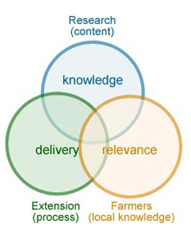Facilitating technology transfer
Implementation
Traditionally, technology transfer depended on information being passed from one partner to another – like the baton in a relay race. This approach often resulted in poor communication between partners, poorly focused research, and poor technology adoption.

 An alternate model for technology transfer
An alternate model for technology transfer
By having partners work together (see figure) rather than in isolation provides a robust model for ensuring relevance and efficiency in Research and Development. In the figure:
- Content – refers to the researcher and knowledge of the technology
- Process – refers to the delivery of the knowledge – packaging and presentation
- Local knowledge – refers to the inclusion of local input to ensure relevance such that identified opportunities consider local conditions, contacts and suitability of technology fit.
The figure highlights the need for interaction, but also indicates that there are opportunities for independent action.
The following table can be used to help identify partner roles. The approach recognizes that active participation and partnership of a range of players including their buy-ins and commitments are keys to success. This methodology has been tested in various scenarios and repeatedly provides a simple functioning model that ensures:
- True opportunities are recognized,
- Real needs versus interests are pursued, and
- All steps and players in the delivery process are considered.








